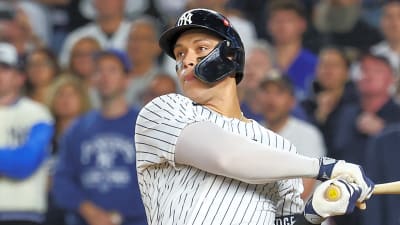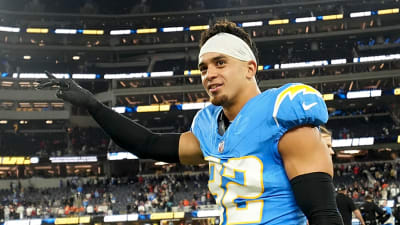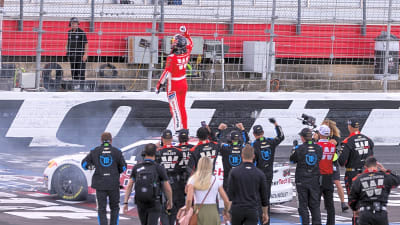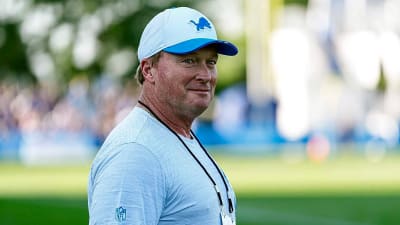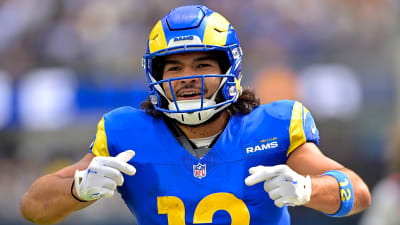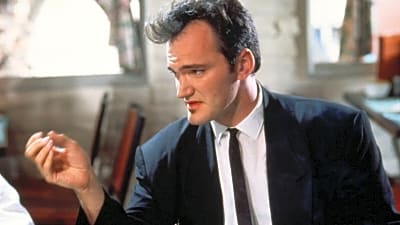
From now until the NFL trade deadline on November 4, the Tuesday following the conclusion of Week 9, we’ll be taking a look around the league at all the different players who could potentially be available on the trade block, using info from beat reporters, national insiders and some judicious dot connecting.
Our first edition of the trade block was last week and already there have been some monumental changes. The biggest was the loss of the No. 1 potential trade target, Dolphins WR Tyreek Hill, after a brutal knee injury in Week 4. There were a litany of reasons it made sense for the Dolphins to shop Hill, even if they hadn’t come to that realization before the injury, but now it’s a moot point and Hill’s future is a topic for the offseason.
There’s still plenty of action to be had before the deadline, though. ESPN’s Adam Schefter said he anticipates a couple of trades a week between now and the deadline, with 10-12 in total by the time it’s in the books. Two of those deals happened on Tuesday. The Bengals and Browns traded for the first time in their respective histories, resulting in Cincinnati getting a new starting quarterback in veteran Joe Flacco. The Ravens and Chargers also executed a rare player-for-player trade, with Baltimore shedding former first-round OLB Odafe Oweh and getting veteran S Alohi Gilman plus a slightly better pick.
All of those events have had ripple effects, so here’s an updated look at our 2025 NFL Midseason Trade Block.
Removed:
- Dolphins WR Tyreek Hill
Added:
- Saints RB Alvin Kamara
- Bears RB Roschon Johnson
- Titans WR Tyler Lockett
- Ravens TE Mark Andrews
- Bengals DE Trey Hendrickson
- Cowboys CB Trevon Diggs
- Jets CB Michael Carter II
Quarterback
- Falcons QB Kirk Cousins
- Giants QB Russell Wilson
The trade of Flacco to the Bengals takes away the most obvious potential landing spot for Cousins and Wilson, making it even less likely that either is moved before the upcoming deadline. Cousins is probably better than Flacco but would have cost the Bengals exponentially more, not only in terms of draft pick compensation but also salary. The Falcons have maintained they don’t want to pick up too much of Cousins’ $27.5 million base salary, and unless that changes it’s hard to see them having much luck with finding a trade partner.
Wilson might have been able to get the ball downfield to Bengals WRs Ja’Marr Chase and Tee Higgins, but he was horrendous in two of his three starts this year and would have had a steeper transition to HC Zac Taylor’s offense. Cincinnati’s struggling offensive line also would have been a bad fit with Wilson. The Giants have made it abundantly clear they would be willing to trade Wilson — it’s just a legitimate question whether they’re going to get any bites.
However, there is always a possibility for an injury to an established starter for a team in playoff contention that isn’t confident in its backup (basically what happened to the Bengals). In that scenario, Cousins and Wilson have appealing resumes. The chances of a trade aren’t good. But they’re not zero, either.
Running Back
- Saints RB Alvin Kamara
- Dolphins RB Jaylen Wright
- Broncos RB Jaleel McLaughlin
- Ravens RB Keaton Mitchell
- Browns RB Jerome Ford
- Texans RB Dameon Pierce
- Raiders RB Raheem Mostert or Zamir White
- Bears RB Roschon Johnson
There’s not a lot of tangible trade buzz about Kamara, and the veteran doesn’t seem to be jonesing to get out even after the 1-4 start to the season. But it’s worth pointing out that backup RB Kendre Miller has progressed with each passing week and is starting to settle into a nice role. Kamara is still a good player, but Miller is also proving he deserves more touches. If a rebuilding New Orleans squad gets a strong offer for Kamara, who turns 31 next July and has $3 million of his $11 million 2026 salary guaranteed, they have to consider it.
Wright hasn’t played yet this season, and when he gets back from his injury he might be third on the depth chart behind sixth-round RB Ollie Gordon, who brings a physical element to the backfield that the other backs on the roster right now don’t. The second-year back was expected to take a leap this year as the complement to starting RB De’Von Achane, but the word out of camp wasn’t necessarily positive. Wright was losing work to RB Alexander Mattison before he was lost for the season due to injury. It would be odd for the Dolphins to give up on a player they traded a third-round pick for the right to draft in the fourth round just last year but there’s a little bit of smoke around the possibility.
McLaughlin has been a healthy scratch behind RB Tyler Badie, who Broncos HC Sean Payton seems determined to mix into the rotation despite having two other strong backs in veteran J.K. Dobbins and second-rounder RJ Harvey. The former UDFA out of Youngstown State has legit wheels and could be a spark for another offense where his path to touches is clearer.
Mitchell dazzled as a rookie in 2023, averaging 8.4 yards per rush and 10.3 yards per catch while scoring twice. Unfortunately he also suffered a gnarly knee injury that limited him to just five games the following year. Mitchell looked all the way back and healthy this preseason but the Ravens like Justice Hill more as a third-down back and Rasheen Ali more as a kickoff returner, leaving Mitchell behind both. It’s probably worth it for other teams to kick the tires and see if the Ravens would like to have a pick or someone else on the roster more than they’d like to keep Mitchell.
Trading Flacco signals the Browns are leaning hard into the youth movement, which should be a warning sign for any veterans left on the roster. Ford has a role still in the backfield but he’s in the final year of his contract. Running backs often don’t have a lot of trade value, but there are some sparse backfields around the league and the Browns should be able to flip Ford for an asset as they lean even more on the youngsters in the backfield.
Pierce was active for Week 1 and Week 5, off the gameday roster in between. He also didn’t get any touches until the game was well in hand against the Ravens, indicating how the Texans see him fitting into a backfield that’s not exactly tearing things up. One team’s trash could be another team’s treasure, though.
One of either Mostert or White will operate from week to week as the handcuff to first-round RB Ashton Jeanty. The other becomes potentially expendable. Mostert has speed, experience and some special teams versatility on his side. White is younger and a hammer. Both are in contract years.
Johnson has been active for three games this season but has not recorded a carry. The competition in the Bears’ backfield isn’t anything to write home about either. Chicago’s running backs are averaging 3.4 yards per carry, but the team evidently doesn’t think Johnson will be able to help improve that number much. The natural next question then is whether it’s worth keeping him on the roster.
Wide Receiver
- Raiders WR Jakobi Meyers
- Bills WR Curtis Samuel
- Titans WRs Tyler Lockett or Van Jefferson
Meyers requested a trade this summer after a lack of progress on contract talks with the Raiders. The 28-year-old veteran is in the final year of his deal and will be an unrestricted free agent next year. Las Vegas rebuffed the request because Meyers is easily the team’s best wideout, but at 1-4, it’ll be interesting to see if the team relents if the losses keep mounting. It’s possible the rebuilding Raiders could get a quality pick for a receiver as established as Meyers, especially since it’s somewhat slim pickings as far as other options this year.
Samuel made his debut in Week 4 and caught one pass. The Bills are probably fine keeping him as depth for the rest of the year, especially because his nearly $7 million salary is already guaranteed. The Bills would also probably be fine with another team taking on that money in a trade. Unfortunately for them, the salary also makes Samuel far less appealing as a trade asset.
The Titans’ receiving corps is about half rookies, half grizzled veterans. The rookies are expected to be the players Tennessee builds around with No. 1 pick and first-round QB Cam Ward. The veterans are there to be a stabilizing presence, and that matters less the more the rookies prove they can play. Jefferson is already sliding down the pecking order. Lockett is playing 50 percent of the snaps but has just seven catches.
Tight End
- Ravens TE Mark Andrews
- Browns TE David Njoku
- Bengals TE Tanner Hudson
There was trade buzz about Andrews this offseason but the Ravens ultimately held onto him for the last year of his contract. For a team looking to not only contend, but claw back from a 1-4 start to the season, it would seem like Baltimore would be taking an all-hands-on-deck approach. However, trading Oweh, a former first-round pick who had 10 sacks last year, shows the Ravens are willing to shake things up in a big way to try and address needs. With TE Isaiah Likely coming back, the Ravens have three starting-caliber players between him, Andrews and Kolar. They also have a ton of weapons on offense. You could make a case that the Ravens could trade Andrews to shore up a different need, possibly on defense, and still be just fine.
Any veterans on expiring contracts are worth watching as potential trade candidates for the Browns, especially the more losses the team accrues. Njoku fits that category, and because of the way his contract is structured with a minimum base salary and most of his compensation already paid out as a bonus, he’s extremely tradable. The Browns should field notable interest from teams interested in adding a boost to their pass-catching group.
The emergence of third-round TE Harold Fannin is a factor here, as the rookie has more targets and catches than Njoku through four games. But the two have very different body types and play different roles in the offense. The more relevant factor for the Browns will be how likely they see the odds of Njoku returning in 2026, as his asking price could be notable and Cleveland will still be rebuilding on a budget.
Hudson’s worth mentioning because the Bengals got even deeper at tight end when they signed veteran Noah Fant and it pushed Hudson even deeper down the depth chart.
Offensive Line
- Giants OL Evan Neal
The demand for competent offensive linemen always exceeds the supply in the NFL, and that’s worsened when the regular season begins and injuries start thinning out the position even more. For that reason, it’s rare to see an in-season trade involving offensive linemen, as teams are trying as hard as they can to cultivate a surplus of depth at the position and not trade it away.
Any exceptions usually involve extenuating circumstances. When it comes to Neal, the former top-ten draft pick has had a plethora of chances to prove himself in the lineup and has come up small each time. The Giants kicked him inside to guard this preseason in a last-ditch effort to help him find a groove, and so far he’s been a healthy scratch in every game. If the Giants get any kind of offer for him after declining his fifth-year option this past May, they’d likely jump at it.
Defensive Tackle
- Browns DT Shelby Harris
- Bills DT Larry Ogunjobi
Harris is in his age-34 season but has been a productive contributor in Cleveland’s dominant defensive line rotation, including the game-winning blocked kick against the Packers in Week 3. He’s another veteran on an expiring deal in Cleveland, and the Browns have enough depth at defensive tackle to be able to part with him for a pick if there’s a contender in need of reinforcements.
Ogunjobi is a unique case because he’s currently serving a six-game suspension after being signed to a notable contract by the Bills this offseason (one year, about $6.6 million). When he returns, he’ll be landing on a loaded depth chart that already includes Ed Oliver, Da’Quan Jones, second-rounder T.J. Sanders, fourth-rounder Deone Walker and Jordan Phillips. That group is playing pretty well, even with Oliver missing some time, and it’d be fair to question where Ogunjobi fits. That could open the door to a trade, as Ogunjobi is on a reasonable $3 million salary for the rest of this season.
Edge Rusher
- Bengals DE Trey Hendrickson
- Dolphins OLBs Bradley Chubb or Jaelan Phillips
- Browns DE Alex Wright or DE Joe Tryon-Shoyinka
- Patriots OLB Anfernee Jennings
- Texans DE Darrell Taylor
Trading Hendrickson would mean throwing the towel in on the season, and the Bengals’ trade for Flacco shows they’re far from ready to do that yet. But if Flacco can’t stem the bleeding and the Bengals can’t get more than two wins going into the trade deadline, then it’s something the organization will have to consider. It feels unlikely that the veteran will be back in 2026 after the tense and drawn-out contract standoff this past year. The two sides reached an uneasy compromise because they felt so strongly about Cincinnati’s chances of contending for a Super Bowl this year. If that goes out the window, the top priority should be salvaging whatever value they can. Hendrickson is pricy but he’s still been a quality pass rusher, and there will be contending teams willing to pay up for that if the Bengals make him available.
As the losses pile up for the Dolphins and the speculation about a rebuild continues to build, there are other big-name players besides Hill that Miami could part with before the trade deadline this year. Both Chubb and Phillips face uncertain long-term futures in Miami and that makes them worth watching. Phillips isn’t under contract past the end of this season as he plays out his fifth-year option worth $13.25 million. Chubb is under contract through 2027 but has no more guarantees on his deal starting in 2026, making him a potential cap casualty.
Both players have dealt with multiple major injuries in their careers, which is a factor both for interested teams and as Miami considers its options with both. Phillips is 26 compared to 29 for Chubb and would probably fetch more in a deal as a result, even though the older Chubb has three sacks compared to none for Phillips so far. Phillips is more likely to be viewed as a potential extension candidate, while Chubb is more likely to be just a rental given his sizable 2026 salary. Given the league-wide demand for pass rushers, the Dolphins would have interest if or when they decide to start selling.
Wright and Tryon-Shoyinka are both on expiring deals. Tryon-Shoyinka was a dart throw signing this offseason as the Browns filled out their rotation. Wright is a former third-round pick who flashed in his first two years before tearing his ACL in 2024. He’s back and so far has been a bright spot in a contract year, perhaps setting himself up for a contract the Browns can’t or don’t want to match in 2026. If they see that coming, it makes some sense to try and lock in a pick for him now instead of playing the compensatory pick game.
Jennings was the subject of some trade rumors this summer but remained on New England’s roster through cutdown day. He’s a workmanlike player who does a lot of dirty work in the run game, but has played a bit role so far this season with around 20 percent of the snaps.
Taylor signed with the Texans as a rotational rusher this offseason but has been a healthy scratch the past two games. If he’s fallen out of favor in Houston, a change of scenery would make a lot of sense. Taylor had 24.5 sacks in his first four seasons, primarily as a sub-package rusher.
Linebacker
- Dolphins LB Willie Gay
- Browns LB Jerome Baker
- Patriots LB Jahlani Tavai
Gay was a camp and preseason standout who looked poised to seize a much bigger role than the Dolphins expected when they signed him to a small contract. Instead, he’s played just 17 snaps. He’s on just a one-year deal, so if the Dolphins aren’t planning to play him, it would make more sense to trade him.
Baker signed a one-year deal this offseason and is playing behind a couple of other players so far to start the season. His deal is structured with a veteran minimum salary, so if the Browns decide to move ahead with other younger options, they should be able to find a taker for Baker.
Tavai has been on the injured list to start the year but he’ll have a chance to factor into the lineup where the Patriots’ incumbents have struggled. However, Tavai will likely run into the same issue a lot of other former holdovers have had with fitting into the new system under HC Mike Vrabel.
Cornerback
- Cowboys CB Trevon Diggs
- Jets CB Michael Carter II
- Seahawks CB Riq Woolen
- Chiefs CB Joshua Williams
Dallas’ struggles on defense to start the season have been well-publicized, and there are a host of issues facing the Cowboys on that side of the ball. One is that new DC Matt Eberflus is working with a few square pegs when it comes to the round holes in his system, and the Cowboys are playing a lot more zone coverage than they did last year. It hasn’t gone well and Diggs was openly asking for more man coverage in interviews this past week. Diggs has also had tension with the coaching staff and front office over his injury rehab and was benched to start last week’s game. It’s not outside the realm of imagination to see the Cowboys being willing to move on if another team is willing to take on the rest of Diggs’ $8.5 million guaranteed salary, even if it does leave a short-term hole at cornerback.
Carter is hurt right now, which makes a trade tough until he heals up, but he should clear the concussion protocol soon. At that point, the Jets could look to shop him. He signed a brand-new contract extension just over a year ago but was banged up in 2024 and now is playing for a different head coach and general manager who aren’t as personally invested. New York has some depth at cornerback, especially after trading for Titans CB Jarvis Brownlee who was billed as a potential nickel coming out as a prospect. Sending out Carter could be the other shoe to drop. He’s due just $1.6 million this year, followed by $9.7 million in 2026 with $1.38 million guaranteed already, plus another $4 million vesting in March. At one point, he was a high-level slot corner, so he could draw some interest.
There was an interesting report about other teams viewing Woolen as a potential trade candidate ahead of the deadline, which is serious buzz to pay attention to. Woolen is in the final year of his contract, has been inconsistent under HC Mike Macdonald and has the athletic gifts to spark some interest from other teams. Seattle is also deep enough at cornerback to be able to make the move with the emergence of some other players, at least it was before a rash of short-term injuries. If those clear up, it’s still possible Woolen could be moved.
Williams is playing a lot on special teams right now but hardly at all on defense after seeing between 30-40 percent of the snaps in each of his first three seasons. That experience could make him appealing for a corner-needy team, and the Chiefs could use Williams as a chip ahead of the deadline to try and add more help to the roster or a future pick.
Safety
- Patriots S Kyle Dugger
- Jets S Tony Adams
- Titans S Quandre Diggs or Xavier Woods
- Panthers S Nick Scott
Dugger ended up sticking on the roster out of the preseason despite major buzz that he could be on the way out. His salary might have been a factor, especially if the Patriots didn’t want to essentially pay him to play somewhere else. The team’s depth at safety isn’t as strong as it was this summer but it’s still possible New England decides a fresh start is the best option here like they did with Jabrill Peppers.
Adams has been usurped by fourth-round S Malachi Moore and is in the final year of his contract. If the Jets don’t plan to bring him back, he makes sense as a trade candidate if he sparks interest from other teams.
The Titans have some depth at safety, including younger players who it makes sense to prioritize snaps for. Third-round S Kevin Winston just made his debut after a torn ACL in his final college season. Freeing up snaps for him might mean removing Diggs or Woods from being roadblocks at some point.
The Panthers also have some young safeties who are operating behind the veteran Scott for now, but should take over as the season progresses, especially if Carolina keeps losing and getting shredded on defense.
More must-reads:
- Giants' Cam Skattebo addresses viral moment after fumble in loss to Saints
- Shedeur Sanders reacts to Browns trading Joe Flacco to Bengals
- The 'Active 10-reception NFL games' quiz
Breaking News
Trending News
Customize Your Newsletter
 +
+
Get the latest news and rumors, customized to your favorite sports and teams. Emailed daily. Always free!

